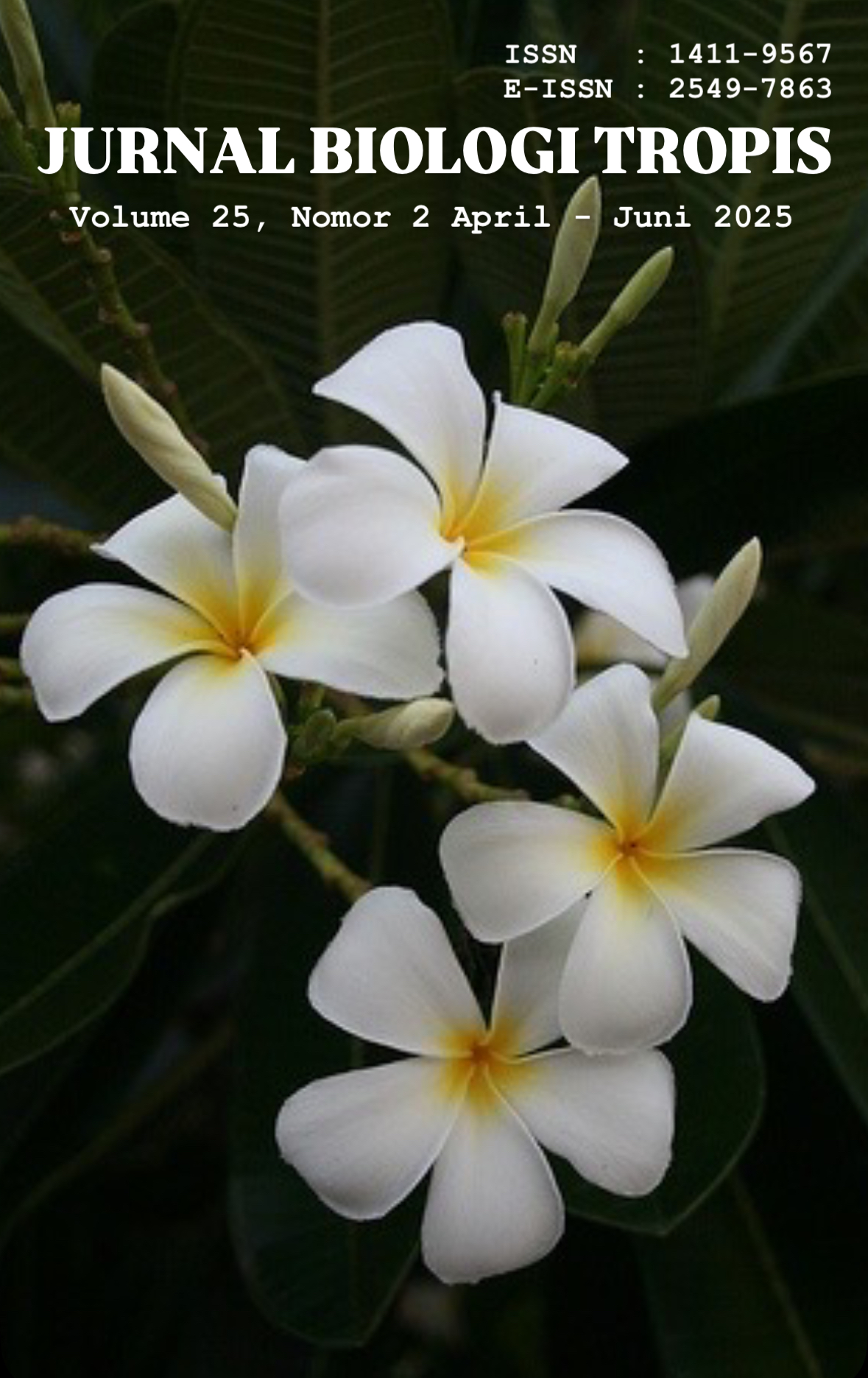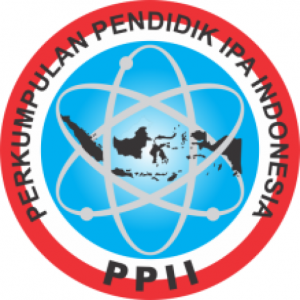Identification of Butterfly Larval Host Plants in the Taman Wisata Alam (TWA) Gunung Tunak, Central Lombok
Authors
Ahmad Jupri , Inda Nur Cahyani , Supardiono Supardiono , Lilik HidayatiDOI:
10.29303/jbt.v25i2.8863Published:
2025-05-22Issue:
Vol. 25 No. 2 (2025): April-JuniKeywords:
Butterfly, conservation, diversity, Gunung Tunak Nature Tourism Park, host plants, species identification.Articles
Downloads
How to Cite
Downloads
Metrics
Abstract
Host plants play an important role in the survival of butterflies, especially in the larval phase which is highly dependent on certain types of plants to obtain nutrients and essential chemicals. Various efforts need to be made to preserve the diversity of butterflies in the Gunung Tunak TWA Area through identification of butterfly larval host plants. This study was conducted to identify the diversity of butterfly larval host plants in the Gunung Tunak Nature Tourism Park, Central Lombok, NTB. Data collection was carried out using the exploration method for four days in two main locations, namely the breeding area and the observation route. The identification results found seven species of host plants, namely Pagoda (Clerodendrum japonicum), Biduri (Calotropis gigantea), Beringin (Ficus hispida), Aristukia (Aristolochia tagala), Bunga Air Mata Pengantin (Antigonon leptopus), Jeruk Purut (Citrus hystrix), and Jeruk Lemon (Citrus limon). Four of the seven plants found are hosts for butterfly larvae of the Nymphalidae family. Aristukia plants were only found in limited numbers, which may affect the survival of the protected butterfly species, Troides helena. These results emphasize the importance of conserving host plants to support the sustainability of butterfly populations in this area.
References
Abdul Hamid, Wahyuningsih, E., & Chaerani, N. (2025). Karakteristik habitat sirih hutan (Aristolochia tagala) sebagai pakan larva Troides helena di Kawasan Taman Nasional Gunung Rinjani Kabupaten Lombok Timur. Bioindikator: Jurnal Biologi dan Pendidikan Biologi, 2(1), 26–42. https://doi.org/10.71024/bioindikator.2025.v2i1.296
Aditya, W., Hutasuhut, M. A., & Tambunan, E. P. S. (2024). Diversity of butterfly types (Lepidoptera: Rhopalocera) based on altitude variations in Sibayak II Forest, North Sumatra. Jurnal Biologi Tropis, 24(1), 8–15. https://doi.org/10.29303/jbt.v24i1.6330
Agustiningrum, A. M., Sulisetijono, S., & Rahayu, S. E. (2022). Preferensi inang Familia Nymphalidae di Kawasan Coban Rais Kota Batu. Jurnal Ilmu Hayat, 6(1), 33–41. https://doi.org/10.17977/um061v6i12022p33-41
Akbar, A. Struktur komunitas dan pemetaan kupu-kupu (lepidoptera: rhophalocera) di Kebun Raya Bogor dengan aplikasi quantum gis (Bachelor's thesis, Fakultas Sains dan Teknologi UIN Syarif Hidayatullah Jakarta).
Ali, R. N., & Sulistiyowati, E. (2019). Pengembangan media pembelajaran biodiversitas berbasis android. Journal of Tropical Chemistry Research and Education, 1(1), 36–42. https://doi.org/10.37079/jtcre.v1i1.21
Apriyeni, B. A. R., Mubarokah, N., Alimran, L. A., & Nisa, J. (2023). Sistem informasi geografis untuk strategi pengembangan Taman Wisata Alam Gunung Tunak berdasarkan evaluasi indeks kelayakan. Geodika: Jurnal Kajian Ilmu dan Pendidikan Geografi, 7(2), 273–284. https://doi.org/10.29408/geodika.v7i2.24347
Aryanti, E., & Suripto, S. (2019). Keanekaragaman tumbuhan inang larva kupu-kupu di Taman Wisata Alam Suranadi. Biologi Wallacea: Jurnal Ilmiah Ilmu Biologi, 5(1), 7–11.
Azahra, S. D. (2021). Potensi jenis kupu-kupu sebagai bioindikator kondisi lingkungan kawasan perkotaan. In Gunung Djati Conference Series (Vol. 6, pp. 102–110).
Baleya, Y. V., Tasirin, J. S., & Pollo, H. N. (2025). Keragaman jenis kupu-kupu pada beberapa tipe tutupan lahan sebagai penunjang ekowisata di wilayah KEK Likupang. Silvarum, 4(1), 46–53. https://doi.org/10.35791/sil.v4i1.58145
Cahyani, E. R., & Mayana, E. (2019). Potensi obyek wisata Taman Wisata Alam Gunung Tunak. Jurnal Sosial Ekonomi dan Humaniora, 5(2), 134–139.
Hamid, A., Wahyuningsih, E., & Chaerani, N. (2025). Karakteristik Habitat Sirih Hutan (Aristolochia tagala) Sebagai Pakan Larva Triodes helena di Kawasan Taman Nasional Gunung Rinjani Resort Timbanuh. Bioindikator: Jurnal Biologi dan Pendidikan Biologi, 2(1), 26-42. https://doi.org/10.71024/bioindikator.2025.v2i1.296
Ilhamdi, M. L., Al Idrus, A., & Santoso, D. (2019). Struktur komunitas kupu-kupu di Taman Wisata Alam Suranadi, Lombok Barat. Jurnal Biologi Tropis, 19(2), 147–153. https://doi.org/10.29303/jbt.v19i2.880
Indriyani, A., Fajri, S. R., & Primawati, S. N. (2021). Hubungan kekerabatan kupu-kupu berdasarkan ciri morfologinya di Taman Wisata Alam Gunung Tunak sebagai bahan pembuatan buku petunjuk praktikum sistematika invertebrata. Jurnal Pijar MIPA, 16(1), 113–120. https://doi.org/10.29303/jpm.v16i1.2051
Kairupan, C. F., Koneri, R., & Tallei, T. E. (2015). Variasi genetik Troides helena (Lepidoptera: Papilionidae) berdasarkan gen COI (Cytochrome C Oxydase I). Jurnal MIPA, 4(2), 141–147. https://doi.org/10.35799/jm.4.2.2015.9039
Kismayanti, C. N., Sari, E. L., Sholechah, F. S., Nissa, F. K., & Tikasari, J. (2022, December). Inventarisasi kelimpahan filum Arthropoda di sekitar kawasan Hutan Penggaron, Kecamatan Ungaran Timur, Kabupaten Semarang, Jawa Tengah. In Seminar Nasional Sains & Entrepreneurship (Vol. 1, No. 1, pp. 15–20).
Lestari, M., Widhiono, I., & Darsono, D. (2020). Keanekaragaman dan kemerataan spesies kupu-kupu (Lepidoptera: Nymphalidae) di Hutan Cagar Alam Bantarbolang, Pemalang, Jawa Tengah. BioEksakta: Jurnal Ilmiah Biologi Unsoed, 2(1), 16–22.
Lestari, D. F., Putri, R. D. A., Ridwan, M., & Purwaningsih, A. D. (2015, September). Keanekaragaman kupu-kupu (Insekta: Lepidoptera) di Wana Wisata Alas Bromo, BKPH Lawu Utara, Karanganyar, Jawa Tengah. In Seminar Nasional Masyarakat Biodiversitas Indonesia (Vol. 1, No. 6, pp. 1284–1288). https://doi.org/10.13057/psnmbi/m010604
Mas’ud, A., Aloysius, D. C., Amin, M., & Rohman, F. (2020). Kupu-kupu endemik Pulau Bacan Ornithoptera croesus dan strategi konservasinya. Sumatra Utara: LPP Balai Insan Cendekia.
Nelyzza, N., & Ningsih, I. K. (2023). Keanekaragaman Kupu-Kupu (Lepidoptera) di Ruang Terbuka Hijau Taman Abhirama, Kabupaten Sidoarjo. Sains dan Matematika, 8(2), 62-68.
Pratama, A. A., Alpiansah, R., Yuliana, I., & Hermanto, A. (2023). Potret pengelolaan berkelanjutan Taman Wisata Alam Gunung Tunak Kabupaten Lombok Tengah. Target: Jurnal Manajemen Bisnis, 5(1), 39–46. https://doi.org/10.30812/target.v5i1.2881
Santosa, Y., Purnamasari, I., & Wahyuni, I. (2017). Perbandingan keanekaragaman kupu-kupu antara tipe tutupan lahan hutan dengan kebun sawit. In Prosiding Seminar Nasional Masyarakat Biodiversitas Indonesia, 3(1), 104–109.https://doi.org/10.13057/psnmbi/m030118
Suyono, I. J., Chrystomo, L. Y., & Budi, I. M. (2019). Pelatihan dan pendampingan perbanyakan tanaman pakan kupu-kupu bagi masyarakat Nimbokrang Kabupaten Jayapura. Jurnal Pengabdian Papua, 3(1), 1–4.
Tresnani, G., Suana, I. W., Hadi, I., Zamroni, Y., Suryadi, B. F., Sadewo, I., & Taqwim, A. (2024). Pengembangan ekowisata berbasis keanekaragaman hayati di Taman Wisata Alam Gunung Tunak, Lombok Tengah. Jurnal Abdi Insani, 11(2), 1012–1019. https://doi.org/10.29303/abdiinsani.v11i2.1376
Tzortzakaki, O., Kati, V., Panitsa, M., Tzanatos, E., & Giokas, S. (2019). Butterfly diversity along the urbanization gradient in a densely-built Mediterranean city: Land cover is more decisive than resources in structuring communities. Landscape and Urban Planning, 183, 79–87. https://doi.org/10.1016/j.landurbplan.2018.11.007
Wahyuni, T. E. (2018). Panduan lapangan kupu-kupu di TWA Gunung Tunak. Mataram: Balai Konservasi Sumber Daya Alam Nusa Tenggara Barat.
License
Copyright (c) 2025 Ahmad Jupri, Inda Nur Cahyani, Supardiono Supardiono, Lilik Hidayati

This work is licensed under a Creative Commons Attribution 4.0 International License.

Jurnal Biologi Tropis is licensed under a Creative Commons Attribution 4.0 International License.
The copyright of the received article shall be assigned to the author as the owner of the paper. The intended copyright includes the right to publish the article in various forms (including reprints). The journal maintains the publishing rights to the published articles.
Authors are permitted to disseminate published articles by sharing the link/DOI of the article at the journal. Authors are allowed to use their articles for any legal purposes deemed necessary without written permission from the journal with an acknowledgment of initial publication to this journal.


























